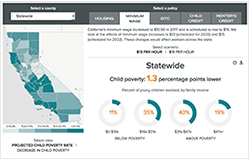Nearly a quarter of young children in California live in poverty-a fact that has profound educational, health, and economic repercussions now and in the long term. High housing costs and low wages are key barriers to reducing the prevalence of child poverty. Lawmakers have taken action to address these issues: the minimum wage is slated to increase to $15 an hour by 2022, and recently enacted laws aim to ease the state’s housing crisis.
This report examines how high housing costs and low wages contribute to poverty among young children ages 0-5 and considers additional policy approaches that could mitigate need among this population. Our related interactive allows for a deeper exploration of how these potential changes could affect California’s diverse counties. We find:
- In California, most young children live in areas with high costs of living, and most parents work. Among poor families with young children, 78 percent of adults work in low-wage jobs and 31 percent pay more than half their income toward housing. The challenges facing these families differ across the state. Those in low-cost areas-mostly inland and northern regions-are more likely to work low-wage jobs, while those in high-cost coastal and urban areas are more likely to pay a large share of their income toward housing. Minimum wage increases and lower housing costs could reduce child poverty substantially, especially in high-cost areas.
- The current safety net is limited in its ability to reach some of the lowest-income families in the state. Devoting more resources to address this gap through, for example, expansions to the state’s Earned Income Tax Credit or a broad-based child credit could assist many severely poor families. Such approaches would have larger impacts on child poverty in low-cost areas. In contrast, rental assistance that targets both low incomes and high housing costs would reduce child poverty to a similar degree across the state. The approaches we examine range widely in estimated total costs, from $417 million to $2.3 billion, and would assist 210,000 to 390,000 young children statewide.
- The current safety net is also limited in its ability to reach low- and moderate-income families who are struggling but may not fully qualify for existing programs-a particular challenge in high-cost areas. Taking into account the cost of living when determining income eligibility for work-based, child, or renter’s credits would help address this gap and could reach those missed by current programs. These approaches range from $4.1 billion to $5.6 billion in estimated total costs and would assist 310,000 to 1.6 million young children statewide.
As with all policy choices, there are trade-offs to consider. In particular, policymakers interested in improving children’s economic well-being must weigh the merits of incentivizing employment by making programs contingent on work versus bolstering income directly. They must also consider how to prioritize improvements in the child poverty rate, the share of children assisted, cost effectiveness, and other measures. For instance, a policy that targets the lowest-income groups is unlikely to affect poverty rates, though it could substantively improve well-being among the most vulnerable.
California faces an uncertain policy environment at the federal level and-after years of robust economic growth-the next recession looms large. Nevertheless, to meaningfully reduce child poverty, policymakers may want to consider strategically expanding programs that help families when earnings fall short. Working toward a future where our youngest children live in families with enough resources to meet basic needs promises to improve their lives and buoy the state’s success as well.

